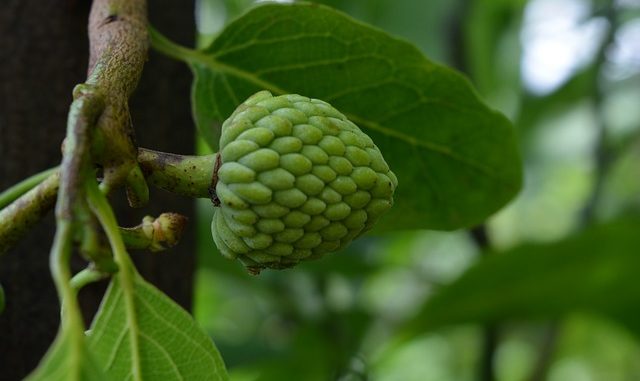
The cherimoya (Annona cherimola, L.) is often considered one of the best-tasting fruits in the world, its commercial production hampered by its short shelf-life, often tender skin and difficulty harvesting the fruit. It is commonly called the custard apple, cherimoya and chirimuya by the Incas.
The fruit is is in the same family as pawpaw and soursop.
Mark Twain thought this fruit was ‘the most delicious fruit known to men’. The cherimoya’s rich and creamy pulp, with a hint of a sweet fruity flavor, makes an excellent dessert fruit and is becoming increasingly popular in temperate climates.
Hardiness
The cherimoya is subtropical and when full-grown can survive to 25ºF. Young trees are susceptible to frost. Sunset Zones: 21-24, H1, H2; 16-20 (marginal) USDA: 10a-11
Growing Environment
Trees do not like intense heat or desert conditions. 50-100 hours of winter temperatures between 32-55°F is usually necessary for fruit production. Cherimoya’s prefer a summer temperature of 65-80ºF, and a winter temperature of 41-65ºF. In cool climates, branches will defoliate for a few months in winter. Cherimoya’s like cool summers and cool nights. Very hot or cold weather, and cold or hot winds can be damaging. Water frequently when the plant is putting out new growth, infrequently when the plant is dormant. Fertilize every three months for best growth. Flowers are formed in small groups at nodes along the branches. A single flower first opens as female, which lasts for 36 hours, followed by a male stage, lasting for another 36 hours. Flowers are almost never pollinated by their own pollen, and without proper pollinators which do not exist outside its native range, cherimoya’s can be hand pollinated for good fruit production. Pollen is generally collected from a few male flowers and stored in a small bag while it is used to pollinate female flowers. Pollen cannot be stored for more than a few hours before it loses viability. Flowers bloom from late winter to early summer, followed by fruit which ripen from October to May.
Propagation
Propagation is by seed, grafting, and air layering. Grafting and air-layering are chosen to propagate select cultivars. Seeds with 70ºF bottom heat may germinate in 1-2 months, but can take up to 4-6 months.
Uses
Almost exclusively eaten fresh, out of hand. The pulp does not store well and the fruit is only available fresh. Seeds are toxic and when crushed can be used as an insecticide.
Native Range
Native to the Andean valleys of Peru, Ecuador, and Colombia. Commercially grown in Australia, South America, Asia, Spain, Italy, and California.
Varieties
Bays – Dates to 1920, James Bays, Ventura, CA. Has medium sized fruits with an excellent flavor showing tones of citrus. Skin somewhat smooth.
El Bumpo – Dates to 1986, Rudy Haluza, Villa Park, CA. Medium to large sized fruits with very soft skin and flesh. Fruits bruise easily. Delicious and sweet flavor, one of the best. Skin has prominent bumps making the fruit look a bit like an atemoya.
McPherson – Medium sized fruits with a rich fruity flavor. Skin is bumpy, soft, with soft flesh. Excellent flavor. Similar to El Bumpo.
Selma – Small to medium sized fruits with mostly white pulp tinted with pink. Notable as it is one of the only cherimoya varieties showing pink color in its pulp.
References
Morton, Julia F. Fruits of Warm Climates. Creative Resources Systems, Inc. 1987. pgs. 65-69.
Leave a Reply